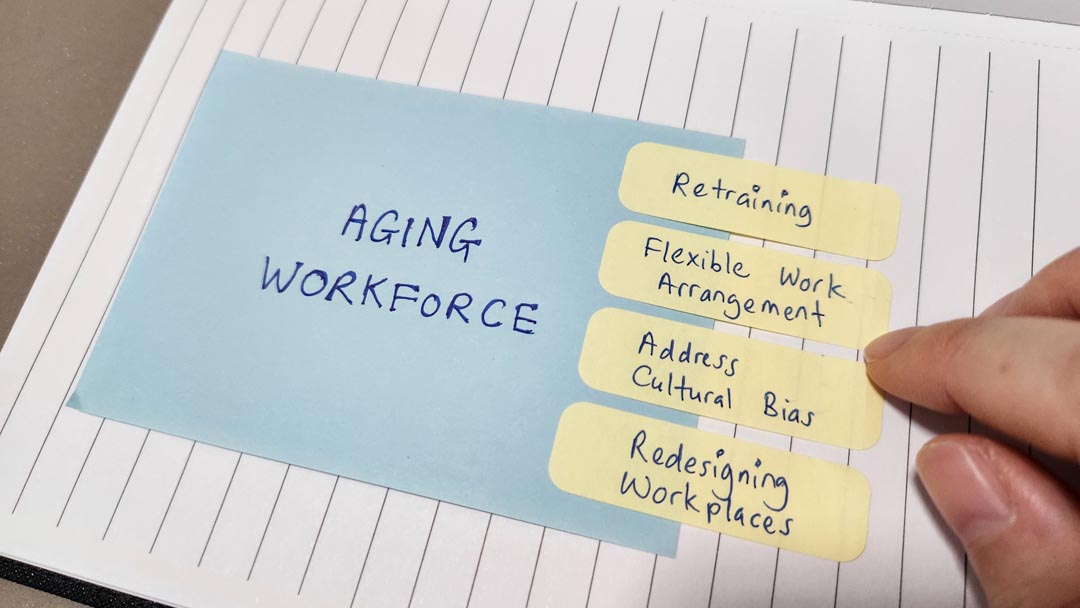David Buchanan and Steve Macaulay explore the perceived challenges and the positive advantages to a workforce with a variety of age ranges
The changing demographics of an ageing population and declining birth rates pose a pressing people management challenge. To address skill and labour shortages, employers must actively recruit, retain and develop older workers. Adaptation requires a targeted approach to HR policies and L&D agendas, recognising and leveraging the valuable experience older workers bring to the workforce.
How old is too old?
Bruce Springsteen, the American singer and guitarist, had his 74th birthday in September 2023. ‘The Boss’ is still touring, playing three-hour sets with his band. Singer Cher has fans anticipating a tour during 2024, to see the 78-year-old belt out their favourites. The Rolling Stones recently released a new album. Their singer, Mick Jagger, celebrated his 80th birthday this year. Rupert Murdoch, media proprietor, is 92. Businesswoman and co-founder of The Huffington Post, Anna Huffington, partnered her Thrive wellness business with Universal Music Group last year – at age 73. Iman Abdulmajid is the 69-year-old model, founder and CEO of the first cosmetics and skincare collection designed for all women with skin of colour. A recent article in Fortune magazine predicts that we will soon see our first 100-year-old CEO.(1)
The population is ageing because life expectancy is increasing, and birth rates are falling. If you are going to live to be 100, then you have one third of your life left if you retire at 65. Continuing to work, and to earn, is attractive for some.
Older workers are discriminated against. They are seen as expensive, unhealthy, less able to learn, less interested in training and development, and resistant to change.
The false stereotype
But the World Health Organization explains, “There is no typical older person. Some 80-year-olds have physical and mental capacities similar to many 30-year-olds”.(2)
Older workers are also conscientious, dependable, experienced, knowledgeable, less error-prone, loyal, and reliable. Healthy older workers perform as well as younger colleagues. One study found that older workers tend to be at least as good as youngsters in several areas.(3)
Research indicates that older workers exhibit a wealth of valuable attributes, displaying practical skills and knowledge, coupled with extensive experience, insightful judgment, and a keen eagerness to share their expertise. For example;
- They are experienced in communication, adeptly tackling problem-solving and navigating challenging situations.
- Recognised for their solid commitment, engagement, and reliability, older workers demonstrate a unique understanding of their older customer base.
- Contributions extend to fostering collaboration within age-diverse teams, blending perspectives, and actively encouraging innovative approaches to work.
This comprehensive set of qualities highlights the substantial strengths that older workers bring to the workforce. And yet, these false negatives exist:
- Only 5% of people over 65 show signs of cognitive impairment.
Most older people are healthy, and those with long-term conditions can still work. Health is affected by many factors other than age, including lifestyle and physical demands. Performance does not necessarily decline with age because most jobs do not ask employees to work at full capacity. - Are older workers resistant to change?
A study in Germany found that older employees were less resistant to change than their younger colleagues.(4) Older workers may have better strategies for coping with and adapting to changing environments. - Older employees can help organisations deal with crises.
Norsk Hydro, a Norwegian electricity company, faced a ransomware attack in 2019. Instead of stopping production, veteran employees, whose careers began in a pre-digital age, switched to manual operations. Younger employees did not have the skills to do this.(5)
Talkin’ ‘bout my generation
Many businesses now have age-diverse workforces. The age range of staff at the fast food chain McDonald’s UK is 75 years: from age 16 to 91. Having many generations in the same workforce can be beneficial. McDonald’s found that multigenerational teams were 10% happier than those working in their peer group. A survey of 1,000 customers found that over 80% liked to see a mix of ages in a restaurant team, because it improves the atmosphere. Older workers deliver better service, and mentor younger staff. Levels of customer service were 20% higher in restaurants with staff aged 60 and over.(6)
The L&D contribution
Staff can be trained to see older workers as valuable colleagues, focusing on their strengths, and on how they complement those of younger workers. Younger managers may find it difficult to manage older, more experienced colleagues. And older employees can resent being told what to do by youngsters. Young managers will benefit from training and coaching in how to manage older colleagues; hint, use their experience. Seniors can coach and mentor younger staff, and may find this satisfying, perhaps in turn being reverse mentored in the use of, for example, social media and AI tools.
Implementing cost-effective strategies to enhance age diversity within the workforce involves a multifaceted approach 9(7):
- Inclusive recruitment practices can be adopted to ensure a diverse pool of candidates, embracing the valuable experiences older workers bring.
- Offering training and development opportunities based on individual needs and preferences, rather than age fosters continuous skill enhancement. Tailoring job designs to suit individual needs also recognises and accommodates the diverse capabilities and preferences of workers.
- Creating multi-generational teams fosters collaboration and knowledge exchange.
- Providing occupational health support acknowledges and addresses the unique health considerations of older workers. Embracing flexible working arrangements accommodates the diverse needs of employees at different life stages.
- Adjusting equipment and facilities in roles with heavy physical demands and long hours ensures a supportive and inclusive working environment for employees of all ages.
Collectively, these measures contribute to a workplace that values and integrates the strengths of employees across generations.
Pledge to practice to performance
Has your organisation made the Age-Friendly Employer Pledge? Here are examples of what this means in practice.
- Age Scotland runs online ‘age-inclusive workplace’ sessions that explore biases and myths about age.
- Aviva Insurance targets recruitment of workers over 50, and offers flexible working, skills development, and mentorship for seniors.
- Boots Pharmacy recruits employees over 50, and provides health support and a menopause-aware workplace policy.
- B&Q Home Improvements provides flexible and part time working and job-sharing for older workers, along with training and mentoring.
- EasyJet, the budget airline, targets over-45 year olds for cabin crew.
Sample development programme
With objectives including dispelling myths, creating an inclusive workplace, and empowering managers, a suggested programme might cover such modules as:
- Insights into older workers
- Creating an inclusive workplace
- Career development
- Managing older workers
- Reverse mentoring
These may be in separate sessions, online learning, standalone or as part of general management development.
The return on experience
Age and experience are valuable commodities. The premium from hiring older workers is called ‘return on experience’. As the population ages, organizations will have to find ways to attract and to retain the knowledge and skills of older employees – and benefit from their contribution to the business.
David Buchanan is Emeritus Professor of Organizational Behaviour at Cranfield University School of Management. He can be reached at: david.buchanan@cranfield.ac.uk
Steve Macaulay is an Associate at Cranfield Executive Development. He can be reached at: s.macaulay@cranfield.ac.uk
References
1. MacLellan, L. (2023). Get ready for the 100-year-old CEO, Fortune, 188(2), pp.38-40.
2. Nicholson, P., Mayho, G., Robson, S., & Sharp, C. (2016). Ageing and the Workplace. London: British Medical Association, Occupational Medicine Committee.
3. World Health Organization (2022). Ageing and Health Factsheet, October: https://www.who.int/news-room/fact-sheets/detail/ageing-and-health.
4. Marvell, R. and Cox, A. (2016). Fulfilling Work: What Do Older Workers Value About Work and Why? London: Institute of Employment Studies and Centre for Ageing Better.
5. Kunze, F., Boehm, S., & Bruch, H. (2013). Age, resistance to change, and job performance. Journal of Managerial Psychology, 28(7/8), 741-760.
6. Braw, E. (2021) ‘Older workers are a secret weapon against cyber attacks’, Financial Times, 6 July, p.21.
7. Clarke, R. (2016). Employees are happier in age-diverse teams, says study. HR Review, 7 September, http://www.hrreview.co.uk/hr-news/employees-happier-age-diverse-teams-says-study/101053
Additional resources
De Smet, A., Mugayar-Baldocchi, M., Reich, A., & Schaninger, B. (2023). Gen What?: Debunking Age-Based Myths About Worker Preferences. New York: McKinsey & Company.
Chartered Institute for Personnel and Development (2016) Creating Longer, More Fulfilling Working Lives: Employer Practice in Five European Countries. London: Chartered Institute for Personnel and Development.




